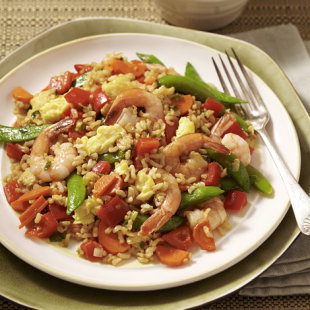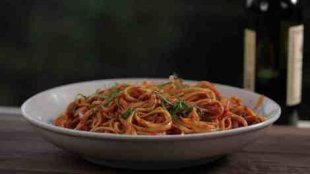6 Quick, Healthy 400-Calorie Recipes for Dinner
By The Editors of EatingWell Magazine | Shine Food – Fri, Jan 25, 2013 3:19 PM EST
Trying to eat healthier and maybe even lose a little weight? Science shows that when it comes to losing weight, what's most important is how much you're eating. (See what a 1,200-calorie day of food looks like.)
Here are some delicious, satisfying and healthy 400-calorie recipes for dinner that are ready in 40 minutes or less to help you eat better and keep your calories in check so you can maintain or lose weight. Serve them with a small side salad to get an extra serving of vegetables for few additional calories.
Shrimp Fried Rice
Makes: 4 servings, 2 cups each
Active time: 40 minutes | Total: 40 minutes
Cost per serving: under $3
Makes: 4 servings, 2 cups each
Active time: 40 minutes | Total: 40 minutes
Cost per serving: under $3
This healthy shrimp fried rice recipe is packed with vegetables and makes 4 generous servings, so you'll need to use a large skillet that is at least 12 inches wide. A large wok also works well. If you have cooked rice on hand, omit Step 1 and add 2 1/2 cups cooked rice to the pan in Step 5.
1 1/2 cups water
1 cup instant brown rice
2 tablespoons hoisin sauce (see Tips)
4 teaspoons reduced-sodium soy sauce
2 teaspoons toasted sesame oil
4 teaspoons canola oil, divided
2 large eggs, lightly beaten
8 ounces peeled and deveined raw small shrimp (51-60 per pound; see Tips)
2 tablespoons minced fresh ginger
4 cups stringless snap peas (12 ounces)
1 medium red bell pepper, cut into
1/2-inch pieces
2 medium carrots, halved lengthwise and thinly sliced
4 scallions, chopped
1 cup instant brown rice
2 tablespoons hoisin sauce (see Tips)
4 teaspoons reduced-sodium soy sauce
2 teaspoons toasted sesame oil
4 teaspoons canola oil, divided
2 large eggs, lightly beaten
8 ounces peeled and deveined raw small shrimp (51-60 per pound; see Tips)
2 tablespoons minced fresh ginger
4 cups stringless snap peas (12 ounces)
1 medium red bell pepper, cut into
1/2-inch pieces
2 medium carrots, halved lengthwise and thinly sliced
4 scallions, chopped
1. Combine water and rice in a small saucepan. Bring to a boil over high heat. Cover, reduce heat to medium-low and simmer until the water is absorbed, 10 to 12 minutes. Spread the rice out on a large baking sheet to cool.
2. Combine hoisin sauce, soy sauce and sesame oil in a small bowl; set aside.
3. Heat 1 teaspoon canola oil in a large nonstick skillet over medium-high heat. Add eggs and cook, stirring to help break into smaller pieces, until just set, about 45 seconds. Transfer the egg to a bowl.
4. Add another 1 teaspoon canola oil to the skillet and return to medium-high heat. Add shrimp and cook, stirring occasionally, until pink, 1 1 /2 to 2 minutes. Transfer the shrimp to the bowl.
5. Heat the remaining 2 teaspoons oil in the skillet over medium-high heat. Add ginger and cook, stirring, until fragrant, about 30 seconds. Stir in snap peas, bell pepper, carrots and scallions; cook, stirring occasionally, until tender-crisp, 3 to 4 minutes. Stir in the rice and the reserved egg and shrimp; cook, stirring, until heated through, about 1 minute. Remove from the heat and gently stir in the sauce mixture.
2. Combine hoisin sauce, soy sauce and sesame oil in a small bowl; set aside.
3. Heat 1 teaspoon canola oil in a large nonstick skillet over medium-high heat. Add eggs and cook, stirring to help break into smaller pieces, until just set, about 45 seconds. Transfer the egg to a bowl.
4. Add another 1 teaspoon canola oil to the skillet and return to medium-high heat. Add shrimp and cook, stirring occasionally, until pink, 1 1 /2 to 2 minutes. Transfer the shrimp to the bowl.
5. Heat the remaining 2 teaspoons oil in the skillet over medium-high heat. Add ginger and cook, stirring, until fragrant, about 30 seconds. Stir in snap peas, bell pepper, carrots and scallions; cook, stirring occasionally, until tender-crisp, 3 to 4 minutes. Stir in the rice and the reserved egg and shrimp; cook, stirring, until heated through, about 1 minute. Remove from the heat and gently stir in the sauce mixture.
Per serving: 307 calories; 11 g fat (2 g sat, 5 g mono); 165 mg cholesterol; 34 g carbohydrate; 2 g added sugars; 17 g protein; 5 g fiber; 462 mg sodium; 523 mg potassium. Nutrition bonus: Vitamin C (157% daily value), Vitamin A (147% dv), Folate (23% dv), Magnesium (21% dv), Iron (18% dv), Potassium (15% dv).
Tips:
Hoisin sauce is a thick, dark brown, spicy-sweet sauce made from soybeans and a complex mix of spices. Look for it in the Asian section of your supermarket.
Hoisin sauce is a thick, dark brown, spicy-sweet sauce made from soybeans and a complex mix of spices. Look for it in the Asian section of your supermarket.
Shrimp is usually sold by the number needed to make one pound. For example, "21-25 count" means there will be 21 to 25 shrimp in a pound. Size names, such as "large" or "extra large," are not standardized, so to get the size you want, order by the count per pound. Both wild-caught and farm-raised shrimp can damage the surrounding ecosystems when not managed properly. Fortunately, it is possible to buy shrimp that have been raised or caught with sound environmental practices. Look for fresh or frozen shrimp certified by an independent agency, such as the Marine Stewardship Council. If you can't find certified shrimp, choose wild-caught shrimp from North America-it's more likely to be sustainably caught.
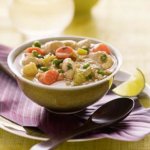 Chicken Coconut Curry
Chicken Coconut CurryMakes: 6 servings, about 1 1/2 cups each
Active time: 50 minutes | Total: 1 hour
Cost per serving: under $3.50
At once comforting and exotic-tasting, this rich chicken coconut curry stew will warm you on chilly winter evenings. Chunks of potato, lean chicken and loads of veggies make it a meal in a bowl. Enjoy with a fruity white wine like Gewurztraminer or Chenin Blanc to tame the heat. Using "lite" coconut milk instead of full-fat in this healthy curried coconut chicken stew recipe trims roughly two-thirds the fat and calories without sacrificing flavor.
1 1/2 pounds boneless, skinless chicken breast, cut into bite-size cubes
6 teaspoons curry powder, divided
3/4 teaspoon salt, divided
2 tablespoons coconut oil or canola oil, divided
1 large yellow onion, chopped
1 tablespoon chopped garlic
1 14-ounce can "lite" coconut milk
1 14-ounce can reduced-sodium chicken broth
4 cups 1-inch chunks Yukon Gold potatoes (about 3 medium)
1 cup sliced carrots
1/2 cup chopped celery
3/4 cup frozen peas
1/4 cup chopped fresh cilantro
1 tablespoon packed brown sugar
6 teaspoons curry powder, divided
3/4 teaspoon salt, divided
2 tablespoons coconut oil or canola oil, divided
1 large yellow onion, chopped
1 tablespoon chopped garlic
1 14-ounce can "lite" coconut milk
1 14-ounce can reduced-sodium chicken broth
4 cups 1-inch chunks Yukon Gold potatoes (about 3 medium)
1 cup sliced carrots
1/2 cup chopped celery
3/4 cup frozen peas
1/4 cup chopped fresh cilantro
1 tablespoon packed brown sugar
1. Place chicken in a medium bowl. Sprinkle with 1 teaspoon curry powder and 1/4 teaspoon salt; toss to coat. Heat 1 tablespoon oil in a large Dutch oven over medium-high heat. Add chicken and cook, stirring once or twice, until mostly browned, 6 to 8 minutes. Transfer to a plate.
2. Heat the remaining 1 tablespoon oil in the pot and add onion and garlic. Cook, stirring often, until the onion is starting to soften, 2 to 4 minutes. Stir in the remaining 5 teaspoons curry powder and cook, stirring, until fragrant but not browned, 30 seconds to 1 minute. Add coconut milk, broth, potatoes, carrots, celery and the remaining 1/2 teaspoon salt and bring to a boil over high heat, stirring often. Reduce heat to medium-low to maintain a gentle simmer and cook, stirring occasionally, until the potatoes and carrots are tender, 10 to 12 minutes.
3. Return the chicken to the pot and add peas. Increase heat to high and continue cooking until the chicken is cooked through, 4 to 5 minutes more. Remove from the heat and stir in cilantro and brown sugar.
2. Heat the remaining 1 tablespoon oil in the pot and add onion and garlic. Cook, stirring often, until the onion is starting to soften, 2 to 4 minutes. Stir in the remaining 5 teaspoons curry powder and cook, stirring, until fragrant but not browned, 30 seconds to 1 minute. Add coconut milk, broth, potatoes, carrots, celery and the remaining 1/2 teaspoon salt and bring to a boil over high heat, stirring often. Reduce heat to medium-low to maintain a gentle simmer and cook, stirring occasionally, until the potatoes and carrots are tender, 10 to 12 minutes.
3. Return the chicken to the pot and add peas. Increase heat to high and continue cooking until the chicken is cooked through, 4 to 5 minutes more. Remove from the heat and stir in cilantro and brown sugar.
Per serving: 346 calories; 12 g fat (8 g sat, 1 g mono); 63 mg cholesterol; 31 g carbohydrate; 2 g added sugars; 29 g protein; 5 g fiber; 574 mg sodium; 934 mg potassium. Nutrition bonus: Vitamin A (77% daily value), Vitamin C (29% dv), Potassium (27% dv), Iron & Magnesium (16% dv).
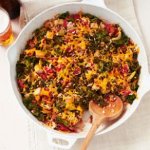 Smoked Turkey, Kale & Rice Bake
Smoked Turkey, Kale & Rice BakeMakes: 6 servings, about 1 1/3 cups each
Active time: 20 minutes | Total: 40 minutes
Cost per serving: under $2.50
This hearty one-skillet dinner is loaded with celery, kale, tomatoes and quick-cooking brown rice. It's easy to make the recipe vegetarian by substituting smoked tofu for the turkey.
1 tablespoon extra-virgin olive oil
2 cups thinly sliced leeks, white and light green parts only
1 cup thinly sliced celery
4 cups slivered kale leaves
1 28-ounce can diced tomatoes
1 cup low-fat, no-salt-added cottage cheese
1 cup instant or quick-cooking brown rice
6 ounces smoked turkey breast or smoked tofu, chopped (1 1/2 cups)
1/4 cup water
1 teaspoon freshly ground pepper, or to taste
1 cup shredded extra-sharp Cheddar cheese
2 cups thinly sliced leeks, white and light green parts only
1 cup thinly sliced celery
4 cups slivered kale leaves
1 28-ounce can diced tomatoes
1 cup low-fat, no-salt-added cottage cheese
1 cup instant or quick-cooking brown rice
6 ounces smoked turkey breast or smoked tofu, chopped (1 1/2 cups)
1/4 cup water
1 teaspoon freshly ground pepper, or to taste
1 cup shredded extra-sharp Cheddar cheese
1. Heat oil in a large, ovenproof skillet over medium-high heat. Add leeks and celery and cook, stirring frequently, until beginning to soften, 2 to 3 minutes. Add kale and tomatoes and cook, stirring, until the kale begins to wilt, 1 to 2 minutes. Stir in cottage cheese, rice, turkey (or tofu), water and pepper. Bring to a simmer. Reduce heat to medium-low, cover and cook for 10 minutes.
2. Meanwhile, position rack in upper third of oven; preheat broiler.
3. Stir the rice mixture, increase the heat to medium and cook, uncovered, until most of the liquid has evaporated, 10 to 12 minutes. Spread cheese on top. Broil until the cheese is bubbling, 2 to 3 minutes.
2. Meanwhile, position rack in upper third of oven; preheat broiler.
3. Stir the rice mixture, increase the heat to medium and cook, uncovered, until most of the liquid has evaporated, 10 to 12 minutes. Spread cheese on top. Broil until the cheese is bubbling, 2 to 3 minutes.
Per serving: 266 calories; 11 g fat (5 g sat, 4 g mono); 33 mg cholesterol; 26 g carbohydrate; 0 g added sugars; 18 g protein; 4 g fiber; 605 mg sodium; 596 mg potassium. Nutrition bonus: Vitamin A (147% daily value), Vitamin C (60% dv), Calcium (26% dv), Magnesium (18% dv), Potassium (17% dv).
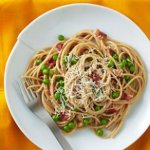 Spaghetti Carbonara with Peas
Spaghetti Carbonara with PeasMakes: 4 servings, about 1 1/2 cups each
Active time: 30 minutes | Total: 30 minutes
Cost per serving: under $1.50
Our healthy spaghetti carbonara recipe is lower in calories and fat than a traditional spaghetti carbonara recipe, plus it boasts 9 more grams of fiber per serving from whole-wheat pasta. For the best flavor, use Parmigiano-Reggiano cheese. The eggs in the sauce are not fully cooked; if you're concerned about consuming undercooked eggs, use pasteurized-in-the-shell eggs in this spaghetti carbonara recipe.
8 ounces whole-wheat spaghetti
2 cups frozen peas, thawed
3 cloves garlic, minced
4 strips thick-cut bacon
2 large eggs, at room temperature (see Tip)
3/4 cup finely shredded Parmesan cheese, divided
1/4 teaspoon salt
1/4 teaspoon freshly ground pepper
2 cups frozen peas, thawed
3 cloves garlic, minced
4 strips thick-cut bacon
2 large eggs, at room temperature (see Tip)
3/4 cup finely shredded Parmesan cheese, divided
1/4 teaspoon salt
1/4 teaspoon freshly ground pepper
1. Bring a large saucepan of water to a boil. Add spaghetti and cook until just tender, 8 to 10 minutes or according to package directions. About 3 minutes before it is done, stir in peas and garlic.
2. Meanwhile, cook bacon in a nonstick skillet over medium heat until crisp. Transfer to a paper towel-lined plate to drain. Scrape the bacon drippings into a large bowl; add eggs, 1/2 cup Parmesan, salt and pepper and whisk until combined.
3. Chop the bacon and add to the egg mixture. When the pasta and peas are done, drain, reserving 3/4 cup of the water. Immediately stir the pasta, peas and the 3/4 cup water into the egg mixture, stirring quickly so the eggs don't scramble. Let stand 5 minutes, stirring occasionally, to thicken the sauce. Serve each portion topped with 1 tablespoon of the remaining cheese.
2. Meanwhile, cook bacon in a nonstick skillet over medium heat until crisp. Transfer to a paper towel-lined plate to drain. Scrape the bacon drippings into a large bowl; add eggs, 1/2 cup Parmesan, salt and pepper and whisk until combined.
3. Chop the bacon and add to the egg mixture. When the pasta and peas are done, drain, reserving 3/4 cup of the water. Immediately stir the pasta, peas and the 3/4 cup water into the egg mixture, stirring quickly so the eggs don't scramble. Let stand 5 minutes, stirring occasionally, to thicken the sauce. Serve each portion topped with 1 tablespoon of the remaining cheese.
Per serving: 385 calories; 10 g fat (4 g sat, 4 g mono); 111 mg cholesterol; 53 g carbohydrate; 0 g added sugars; 23 g protein; 10 g fiber; 659 mg sodium; 320 mg potassium. Nutrition bonus: Vitamin A (33% daily value), Magnesium (28% dv), Calcium (25% dv), Iron & Vitamin C (22% dv), Folate (21% dv), Zinc (20% dv).
Tip: To bring eggs to room temperature, either set them out on the counter for 15 minutes or submerge them (in the shell) in a bowl of lukewarm (not hot) water for 5 minutes.
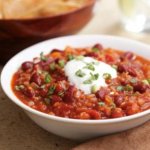
Half-Hour Chili
Makes: 6 servings, about 1 1/3 cups each
Active time: 15 minutes | Total: 30 minutes
Makes: 6 servings, about 1 1/3 cups each
Active time: 15 minutes | Total: 30 minutes
This truly tasty half-hour vegetarian chili is made possible by using convenient canned beans and tomatoes (no pantry should be without them). Whole-grain bulgur adds another layer of toothsome texture and nutritional heft. This chili is relatively mild, so it's a good crowd-pleaser. If you like it spicy, add extra chili powder or serve with hot sauce.
1 tablespoon canola oil
3 medium onions, chopped
1 carrot, chopped
1 tablespoon finely chopped jalapeño pepper
2 cloves garlic, finely chopped
1-2 tablespoons chili powder
1 teaspoon ground cumin
1 28-ounce can plus one 14-ounce can whole tomatoes, chopped, with juices
1 teaspoon brown sugar
1/4 teaspoon salt
2 15-ounce cans red kidney beans, rinsed
1/3 cup bulgur (see Note)
1/2 cup nonfat plain yogurt for garnish
1/3 cup chopped scallions for garnish
1/4 cup chopped fresh cilantro for garnish
3 medium onions, chopped
1 carrot, chopped
1 tablespoon finely chopped jalapeño pepper
2 cloves garlic, finely chopped
1-2 tablespoons chili powder
1 teaspoon ground cumin
1 28-ounce can plus one 14-ounce can whole tomatoes, chopped, with juices
1 teaspoon brown sugar
1/4 teaspoon salt
2 15-ounce cans red kidney beans, rinsed
1/3 cup bulgur (see Note)
1/2 cup nonfat plain yogurt for garnish
1/3 cup chopped scallions for garnish
1/4 cup chopped fresh cilantro for garnish
1. Heat oil in a Dutch oven over medium heat. Add onions, carrot, jalapeño, garlic, chili powder to taste and cumin. Cook, stirring often, until the onions and carrot are soft, 5 to 7 minutes.
2. Add tomatoes with their juices, sugar and salt; cook for 5 minutes over high heat. Reduce heat to low; stir in beans and bulgur. Simmer until the chili is thickened, about 15 minutes.
3. Garnish with yogurt, scallions and cilantro, if desired.
2. Add tomatoes with their juices, sugar and salt; cook for 5 minutes over high heat. Reduce heat to low; stir in beans and bulgur. Simmer until the chili is thickened, about 15 minutes.
3. Garnish with yogurt, scallions and cilantro, if desired.
Per serving: 217 calories; 3 g fat (0 g sat, 2 g mono); 0 mg cholesterol; 40 g carbohydrate; 1 g added sugars; 10 g protein; 13 g fiber; 697 mg sodium; 854 mg potassium.
Nutrition bonus: Vitamin A (49% daily value), Vitamin C (43% dv), Potassium (25% dv), Folate & Iron (24% dv), Magnesium (20% dv).
Nutrition bonus: Vitamin A (49% daily value), Vitamin C (43% dv), Potassium (25% dv), Folate & Iron (24% dv), Magnesium (20% dv).
Note: Bulgur is made by parboiling, drying and coarsely grinding or cracking wheat berries. Don't confuse bulgur with cracked wheat, which is simply that-cracked wheat. Since the parboiling step is skipped, cracked wheat must be cooked for up to an hour whereas bulgur simply needs a quick soak in hot water for most uses. Look for it in the natural-foods section of large supermarkets, near other grains, or online at kalustyans.com, buylebanese.com.
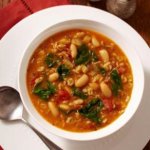
Bean & Barley Soup
Makes: 4 servings, 2 1/2 cups each
Active time: 30 minutes | Total: 45 minutes
To make ahead: Refrigerate for up to 3 days or freeze for up to 6 months.
Cost per serving: under $4
Makes: 4 servings, 2 1/2 cups each
Active time: 30 minutes | Total: 45 minutes
To make ahead: Refrigerate for up to 3 days or freeze for up to 6 months.
Cost per serving: under $4
This hearty bean and barley soup tastes like it has simmered for hours, but actually it's quite quick to throw together. Plus this recipe for healthy bean and barley soup freezes beautifully. If you have cooked barley on hand, omit the quick-cooking barley and stir in 1 1/2 cups cooked barley along with the broth in Step 2.
1 1/2 cups cooked barley along with the broth in Step 2.
4 teaspoons extra-virgin olive oil
1 large onion, chopped
1 medium fennel bulb, cored and chopped
5 cloves garlic, minced
1 teaspoon dried basil
1 15-ounce can cannellini or other white beans, rinsed
4 teaspoons extra-virgin olive oil
1 large onion, chopped
1 medium fennel bulb, cored and chopped
5 cloves garlic, minced
1 teaspoon dried basil
1 15-ounce can cannellini or other white beans, rinsed
1 14-ounce can fire-roasted diced tomatoes
6 cups low-sodium vegetable broth
3/4 cup quick-cooking barley
1 5-ounce package baby spinach (6 cups)
1/4 cup grated Parmesan cheese
1/4 teaspoon ground pepper
6 cups low-sodium vegetable broth
3/4 cup quick-cooking barley
1 5-ounce package baby spinach (6 cups)
1/4 cup grated Parmesan cheese
1/4 teaspoon ground pepper
1. Heat oil in a Dutch oven over medium-high heat. Add onion, fennel, garlic, and basil; cook, stirring frequently, until tender and just beginning to brown, 6 to 8 minutes.
2. Mash 1/2 cup of the beans. Stir the mashed and whole beans, tomatoes, broth and barley into the pot. Bring to a boil over high heat. Reduce heat to medium and simmer, stirring occasionally, until the barley is tender, about 15 minutes. Stir in spinach and cook until wilted, about 1 minute. Remove from the heat and stir in cheese and pepper.
2. Mash 1/2 cup of the beans. Stir the mashed and whole beans, tomatoes, broth and barley into the pot. Bring to a boil over high heat. Reduce heat to medium and simmer, stirring occasionally, until the barley is tender, about 15 minutes. Stir in spinach and cook until wilted, about 1 minute. Remove from the heat and stir in cheese and pepper.
Per serving: 323 calories; 7 g fat (2 g sat, 4 g mono); 4 mg cholesterol; 55 g carbohydrate; 0 g added sugars; 13 g protein; 13 g fiber; 767 mg sodium; 795 mg potassium. Nutrition bonus: Vitamin A (98% daily value), Vitamin C (67% dv), Folate (28% dv), Potassium (23% dv), Calcium (20% dv), Iron (18% dv).
